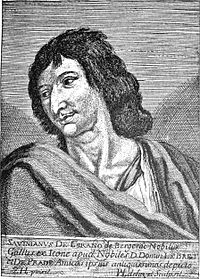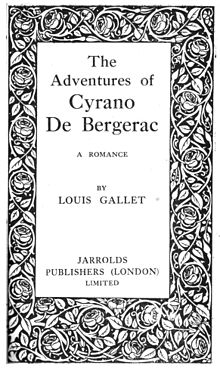- Cyrano de Bergerac
-
For other uses, see Cyrano de Bergerac (disambiguation).
Cyrano de Bergerac 
Cyrano de BergeracBorn 6 March 1619
Sannois, FranceDied 28 July 1655 (aged 36)
Paris, FranceOccupation Playwright, Soldier Hercule-Savinien de Cyrano de Bergerac (6 March 1619 – 28 July 1655) was a French dramatist and duelist. He is now best remembered for the works of fiction which have been woven, often very loosely, around his life story, most notably the 1897 play by Edmond Rostand. In these fictional works he is featured with an overly large nose, which people would travel from miles around to see. Portraits suggest that he did have a big nose, though not nearly as large as described in Rostand's play and the subsequent works about him. His work furnished models and ideas for subsequent writers.
Contents
Life and works
He was the son of Abel de Cyrano, lord of Mauvières and Bergerac. He received his first education from a country priest, and had for a fellow pupil his friend and future biographer, Henri Lebret. He then proceeded to Paris to the college de Beauvais, where he had for master Jean Grangier, whom he afterwards ridiculed in his comedy Le Pédant joué (The Pedant Tricked) of 1654. At the age of nineteen, he entered a corps of the guards, serving in the campaigns of 1639 and 1640.[1]
Research indicates that around 1640 he became the lover of Charles Coypeau d'Assoucy, a writer and musician, until around 1653, when they became engaged in a bitter rivalry. This led to Bergerac sending d'Assoucy death threats that compelled him to leave Paris. The quarrel extended to a series of satirical texts by both men.[2] Bergerac wrote Contre Soucidas (an anagram of his enemy's name) and Contre un ingrat ("Against an Ingrate"), while D’Assoucy counterattacked with Le Combat de Cyrano de Bergerac avec le singe de Brioché, au bout du Pont-Neuf.
He is said to have fought more than 1000 duels, mostly on account of his nose.[3] The story of his adventure single-handed against a hundred enemies was vouched for by Lebret as the simple truth. After two years in the guards, Cyrano left the service and returned to Paris to pursue literature, producing tragedies cast in the orthodox classical mode.[1]
The model for the Roxane character of the Rostand play was Bergerac's cousin, who lived with his sister, Catherine de Cyrano, at the Convent of the Daughter of the Cross[4] As in the play, Bergerac did fight at the siege of Arras (1640), a battle of the Thirty Years' War between French and Spanish forces in France (though this was not the more famous final Battle of Arras, fought fourteen years later). One of his confreres in the battle was the Baron Christian of Neuvillette, who married Cyrano's cousin. However, the plotline of the play, Cyrano de Bergerac, involving Roxane and Christian is entirely fictional.
Cyrano was a freethinker and a pupil of Pierre Gassendi, a canon of the Catholic Church who tried to reconcile Epicurean atomism with Christianity. Cyrano's insistence on reason was rare in his time. His tragedy Mort d'Agrippine (1654) was regarded at the time as the vehicle of atheistic teaching.[3]
He was injured by a falling wooden beam in 1654 while entering the house of his patron, the Duc D'Arpajon. Whether it was a deliberate attempt on his life or merely an accident is unknown. It is also inconclusive as to whether or not his death was a result of the injury, or an unspecified disease.[5] He died over a year later on July 28, 1655 aged 36. His place of death was the house of his cousin, Pierre De Cyrano, in Sannois.[6] He was buried in a church in Sannois.
Cyrano de Bergerac's works L'Autre Monde: où les États et Empires de la Lune (The Other World: The States and Empires of the Moon) (published posthumously, 1657) and Les États et Empires du Soleil (The States and Empires of the Sun) (1662) are classics of early modern science fiction. In the former, Cyrano travels to the moon using rockets powered by firecrackers and meets the inhabitants. The moon-men have four legs, musical voices, and firearms that shoot game and cook it.
His mixture of science and romance in the last two works furnished a model for many subsequent writers, among them Jonathan Swift, Edgar Alan Poe and probably Voltaire. Corneille and Molière freely borrowed ideas from Le Pédant joué.[1][3]
In fiction
French literature By category French literary history French writers Chronological list
Writers by category
Novelists · Playwrights
Poets · Essayists
Short story writersPortals France · Literature Rostand
In 1897, the French poet Edmond Rostand published a play, Cyrano de Bergerac, on the subject of Cyrano's life. This play, by far Rostand's most successful work, concentrates on Cyrano's love for the beautiful Roxane, whom he is obliged to woo on behalf of a more conventionally handsome but less articulate friend, Christian de Neuvillette.
The play has been adapted for cinema several times, most recently in 1990 with Gerard Depardieu in the title role. That 1990 version's dialogue is in French with subtitles written by Anthony Burgess in rhymed couplets, mirroring the form of the dialogue in the original play. The most famous film version in English is the 1950 film, with José Ferrer in the title role, a performance for which he won the Academy Award for Best Actor. In 1959, Hiroshi Inagaki wrote and directed a Japanese version, Aru kengo no shogai (Samurai Saga AKA Life of a Expert Swordsman), setting the story in 17th century Shogunate Japan and starring Toshirō Mifune as the Cyrano character "Heihachiro Komaki" and Yoko Tsukasa as the Roxanne character "Lady Ochii". Ferrer reprised the role in the 1960 French film Cyrano et d'Artagnan, directed by Abel Gance, opposite Jean-Pierre Cassel as D'Artagnan. Much later, Cassel made a cameo appearance as Cyrano de Bergerac in The Return of the Musketeers: the character was depicted as fifty-something and attempting to travel to the Moon with the aid of a balloon.
Other works
"The Adventures of Cyrano De Bergerac", by Louis Gallet, was published in English by Jarrolds Publishers (London) in 1900. This is a swashbuckling tale of adventure and romance bearing no resemblance to Rostand's play, other than the outstanding physical characteristics of the De Bergerac character.
Other film interpretations of Rostand include the romantic comedies Roxanne, and The Truth About Cats & Dogs, respectively starring Steve Martin and Janeane Garofalo in the Cyrano-like roles. Cyrano Fernández (2007) is a retelling from Venezuela, set in contemporary times, in which Cyrano is disfigured but lacks the large nose.
Geraldine McCaughrean rewrote the play as a novel entitled Cyrano, which was longlisted for the Carnegie Award in 2007. In 1936, Franco Alfano composed his opera, Cyrano de Bergerac, to a libretto based on the play. David Bintley, Director of Birmingham Royal Ballet, created a ballet of the story in 2007. Most recently, David DiChiera rewrote the play as another opera entitled Cyrano, which was produced first by Michigan Opera Theater and then by the Opera Company of Philadelphia (February 2008).
The character of Cyrano also inspired a song, "Cyrano," by Italian performer Francesco Guccini about the hypocrisy, servitude to conventions, and superficialities of modern show business and political society. Savinien de Cyrano de Bergerac is one of the main characters in Philip José Farmer's Riverworld novels.
A couple of characters in modern works are based on Cyrano, although not named as such. Robert Heinlein's Glory Road features a cameo appearance by such a figure. The Swordmaster in Alain Ayrole's and Jean-Luc Masbou's French comic book De cape et de crocs portrays a colorful gentleman living on the Moon, at ease either with a sword or with a sonnet, and using both to silence those foolish enough to mock his prominent nose.
"Sir Nose D’Voidoffunk" is a character with a Pinocchio-like nose, whose moniker is a play on the name "Cyrano de Bergerac." Sir Nose is an antagonist within P-Funk mythology, and first appears on the album Funkentelechy Vs. the Placebo Syndrome by Parliament.
In 1995, the award-winning Scottish novelist A. L. (Alison) Kennedy featured a newly-revived Cyrano in her novel 'So I am glad'. The heroine finds him entering her life where she is under stress as a radio 'voice'. We are left unsure whether Cyrano has returned to live with her as her lover for a time or is a figment of her imagination. In any case, she is engaged by the vitality of his character, his revisiting the events of his life and his unorthodoxy and adventures in modern Glasgow.
In 1998, James L. Carcioppolo wrote and published The Lost Sonnets of Cyrano de Bergerac. The book fictionalizes a dying Cyrano writing a sequence of sonnets in an attempt to come to terms with his conflicted life. It portrays a Cyrano very close to the historical personage without diminishing his love for freedom and individuality.
Influence
The ghostwritten love letters of Cyrano de Bergerac are said to have inspired Heart Raps, a modern day service that writes custom romantic hip-hop verses to be given as gifts [7].
See also
- Asteroid 3582 Cyrano, named after de Bergerac.
- Cyrano (Damrosch), a four-act opera with music by Walter Damrosch and libretto by William J. Henderson
- Cyrano (opera), an opera in three acts by David DiChiera to a libretto by Bernard Uzan
- Cyrano de Bergerac (Alfano), a four-act opera with music by Franco Alfano and libretto by Henri Caïn
- Cyrano de Bergerac (film)
- Cyrano de Bergerac (play)
- Roxanne (film)
- Addyman, Ishbel (2008). Cyrano: The Life and Legend of Cyrano De Bergerac, Simon & Schuster
References
- ^ a b c
 Chisholm, Hugh, ed (1911). "Cyrano de Bergerac, Savinien". Encyclopædia Britannica (11th ed.). Cambridge University Press.
Chisholm, Hugh, ed (1911). "Cyrano de Bergerac, Savinien". Encyclopædia Britannica (11th ed.). Cambridge University Press. - ^ Addyman, Ishbel, Cyrano: The Life and Legend of Cyrano de Bergerac, (Simon & Schuster, 2008), ISBN 0743286197
- ^ a b c
 "Bergerac, Savinien Cyrano de". Encyclopedia Americana. 1920.
"Bergerac, Savinien Cyrano de". Encyclopedia Americana. 1920. - ^ Coolfrencomics.com
- ^ Afterword to Cyrano de Bergerac’s The Other World - by Don Webb
- ^ Cyranodebergerac.fr
- ^ http://www.heart-raps.com
External links
- Brief biography at Kirjasto (Pegasos)
- Le Vrai Cyrano de Bergerac (French)—Biography
- Cyrano(s) de Bergerac (French)—Information on fictional portrayals versus real person
- The Other World: Society and Government of the Moon—annotated English language edition
- Cyrano de Bergerac at Project Gutenberg—English language edition.
- Cyrano de Bergerac at Project Gutenberg—French language edition.
Categories:- 1619 births
- 1655 deaths
- French dramatists and playwrights
- French science fiction writers
- Lycée Louis-le-Grand alumni
- Moon in fiction
- Writers from Paris
Wikimedia Foundation. 2010.

